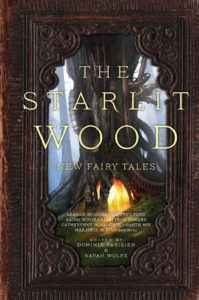 Today in The Starlit Wood blog series one of my favourite writers, the amazing Jeffrey Ford, talks about his tale “The Thousand Eyes”.
Today in The Starlit Wood blog series one of my favourite writers, the amazing Jeffrey Ford, talks about his tale “The Thousand Eyes”.
1. What was the inspiration for your story in The Starlit Wood?
We were asked by the editors to pick an old fairy tale and to write a modern variation on it. When I got their email, I stood up from my desk, walked over to the book shelf in my office that held the fairy tale books, pulled out one of the Andrew Lang editions, opened it and landed on “The Voice of Death,” an old Romanian tale. I read the tale and then set it aside until the day I was ready to begin writing. On the day I was to start writing my version, just before waking, I had a dream about my mother’s funeral. We were driving out on Long Island, somewhere near Yaphank, and the limo we were in passed a burned-out night club with a big sign out front that announced – The Thousand Eyes. I took that as the title of my riff on “The Voice of Death” and went with it.
2. What appealed to you about a fairy tale anthology?
Fairy Tales are always fun, always weird and harrowing, and often have a resonance with the present-day world and its trials, tribulations and joys. The real thing that interested me in the project, though, was an opportunity to work with two relatively new, young, anthology editors that seemed to have it together. My intuition was borne out in that The Starlit Wood was considered one of the best anthologies of the year it came out. It won the Shirley Jackson Award for best anthology and has been nominated for the World Fantasy Award in the same category.
3. Can you recall the first fairy tale you ever read or that was read to you?
That’s going back quite a way now and so my memory of these things grows murky, but I do recall Little Red Riding Hood, The Three Little Pigs, The Billy Goats Gruff (never knew what the hell a “gruff” was) and some horrible story where a woman ends up vomiting frogs and snakes.
4. What’s your favorite folk/fairy tale and why? 
My favorite stories along these lines are the voyages of Sinbad the Sailor which appear in the Thousand and One Nights. Granted, they aren’t of European origin, but they have all the imaginative power of the Grimm Brothers’ best and are also cultural touchstones. Sinbad’s thirst for adventure, his errant wandering on the open seas, the monsters he battles, all delighted me when I first read them. The thrill they provided, I found again, later in life, in the stories of Maqroll, the gaviero, written by Alvaro Mutis.
5. What’s next for you?
For the next few months, I’ll be working on a novella and editing a novel that will be coming out from Morrow/Harper Collins next May – Ahab’s Return, or The Last Voyage.
Jeffrey Ford is the author of the novels, Vanitas, The Physiognomy, Memoranda, The Beyond, The Portrait of Mrs Charbuque, The Girl in the Glass, The Cosmology of the Wider World, and The Shadow Year. His story collections are The Fantasy Writer’s Assistant, The Empire of Ice Cream, The Drowned Life, and Crackpot Palace. His latest collection, The Natural History of Hell, won the 2016 World Fantasy Award for Best Collection. He lives in Ohio and currently teaches part-time at Ohio Wesleyan University.

